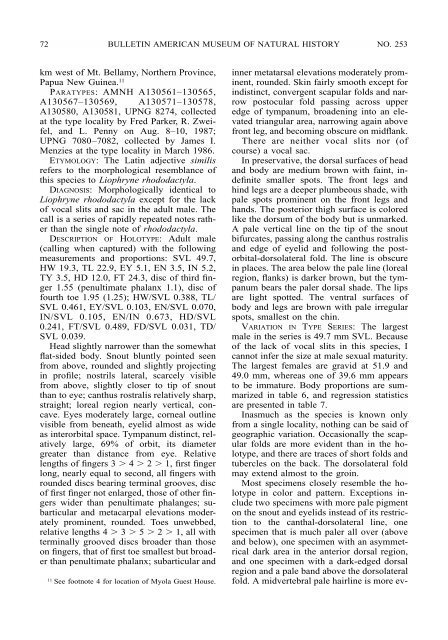SPHENOPHRYNE - American Museum of Natural History
SPHENOPHRYNE - American Museum of Natural History
SPHENOPHRYNE - American Museum of Natural History
You also want an ePaper? Increase the reach of your titles
YUMPU automatically turns print PDFs into web optimized ePapers that Google loves.
72 BULLETIN AMERICAN MUSEUM OF NATURAL HISTORY NO. 253<br />
km west <strong>of</strong> Mt. Bellamy, Northern Province,<br />
Papua New Guinea. 11<br />
PARATYPES: AMNH A130561–130565,<br />
A130567–130569, A130571–130578,<br />
A130580, A130581, UPNG 8274, collected<br />
at the type locality by Fred Parker, R. Zweifel,<br />
and L. Penny on Aug. 8–10, 1987;<br />
UPNG 7080–7082, collected by James I.<br />
Menzies at the type locality in March 1986.<br />
ETYMOLOGY: The Latin adjective similis<br />
refers to the morphological resemblance <strong>of</strong><br />
this species to Liophryne rhododactyla.<br />
DIAGNOSIS: Morphologically identical to<br />
Liophryne rhododactyla except for the lack<br />
<strong>of</strong> vocal slits and sac in the adult male. The<br />
call is a series <strong>of</strong> rapidly repeated notes rather<br />
than the single note <strong>of</strong> rhododactyla.<br />
DESCRIPTION OF HOLOTYPE: Adult male<br />
(calling when captured) with the following<br />
measurements and proportions: SVL 49.7,<br />
HW 19.3, TL 22.9, EY 5.1, EN 3.5, IN 5.2,<br />
TY 3.5, HD 12.0, FT 24.3, disc <strong>of</strong> third finger<br />
1.55 (penultimate phalanx 1.1), disc <strong>of</strong><br />
fourth toe 1.95 (1.25); HW/SVL 0.388, TL/<br />
SVL 0.461, EY/SVL 0.103, EN/SVL 0.070,<br />
IN/SVL 0.105, EN/IN 0.673, HD/SVL<br />
0.241, FT/SVL 0.489, FD/SVL 0.031, TD/<br />
SVL 0.039.<br />
Head slightly narrower than the somewhat<br />
flat-sided body. Snout bluntly pointed seen<br />
from above, rounded and slightly projecting<br />
in pr<strong>of</strong>ile; nostrils lateral, scarcely visible<br />
from above, slightly closer to tip <strong>of</strong> snout<br />
than to eye; canthus rostralis relatively sharp,<br />
straight; loreal region nearly vertical, concave.<br />
Eyes moderately large, corneal outline<br />
visible from beneath, eyelid almost as wide<br />
as interorbital space. Tympanum distinct, relatively<br />
large, 69% <strong>of</strong> orbit, its diameter<br />
greater than distance from eye. Relative<br />
lengths <strong>of</strong> fingers 3 4 2 1, first finger<br />
long, nearly equal to second, all fingers with<br />
rounded discs bearing terminal grooves, disc<br />
<strong>of</strong> first finger not enlarged, those <strong>of</strong> other fingers<br />
wider than penultimate phalanges; subarticular<br />
and metacarpal elevations moderately<br />
prominent, rounded. Toes unwebbed,<br />
relative lengths 4 3 5 2 1, all with<br />
terminally grooved discs broader than those<br />
on fingers, that <strong>of</strong> first toe smallest but broader<br />
than penultimate phalanx; subarticular and<br />
11 See footnote 4 for location <strong>of</strong> Myola Guest House.<br />
inner metatarsal elevations moderately prominent,<br />
rounded. Skin fairly smooth except for<br />
indistinct, convergent scapular folds and narrow<br />
postocular fold passing across upper<br />
edge <strong>of</strong> tympanum, broadening into an elevated<br />
triangular area, narrowing again above<br />
front leg, and becoming obscure on midflank.<br />
There are neither vocal slits nor (<strong>of</strong><br />
course) a vocal sac.<br />
In preservative, the dorsal surfaces <strong>of</strong> head<br />
and body are medium brown with faint, indefinite<br />
smaller spots. The front legs and<br />
hind legs are a deeper plumbeous shade, with<br />
pale spots prominent on the front legs and<br />
hands. The posterior thigh surface is colored<br />
like the dorsum <strong>of</strong> the body but is unmarked.<br />
A pale vertical line on the tip <strong>of</strong> the snout<br />
bifurcates, passing along the canthus rostralis<br />
and edge <strong>of</strong> eyelid and following the postorbital-dorsolateral<br />
fold. The line is obscure<br />
in places. The area below the pale line (loreal<br />
region, flanks) is darker brown, but the tympanum<br />
bears the paler dorsal shade. The lips<br />
are light spotted. The ventral surfaces <strong>of</strong><br />
body and legs are brown with pale irregular<br />
spots, smallest on the chin.<br />
VARIATION IN TYPE SERIES: The largest<br />
male in the series is 49.7 mm SVL. Because<br />
<strong>of</strong> the lack <strong>of</strong> vocal slits in this species, I<br />
cannot infer the size at male sexual maturity.<br />
The largest females are gravid at 51.9 and<br />
49.0 mm, whereas one <strong>of</strong> 39.6 mm appears<br />
to be immature. Body proportions are summarized<br />
in table 6, and regression statistics<br />
are presented in table 7.<br />
Inasmuch as the species is known only<br />
from a single locality, nothing can be said <strong>of</strong><br />
geographic variation. Occasionally the scapular<br />
folds are more evident than in the holotype,<br />
and there are traces <strong>of</strong> short folds and<br />
tubercles on the back. The dorsolateral fold<br />
may extend almost to the groin.<br />
Most specimens closely resemble the holotype<br />
in color and pattern. Exceptions include<br />
two specimens with more pale pigment<br />
on the snout and eyelids instead <strong>of</strong> its restriction<br />
to the canthal-dorsolateral line, one<br />
specimen that is much paler all over (above<br />
and below), one specimen with an asymmetrical<br />
dark area in the anterior dorsal region,<br />
and one specimen with a dark-edged dorsal<br />
region and a pale band above the dorsolateral<br />
fold. A midvertebral pale hairline is more ev-
















